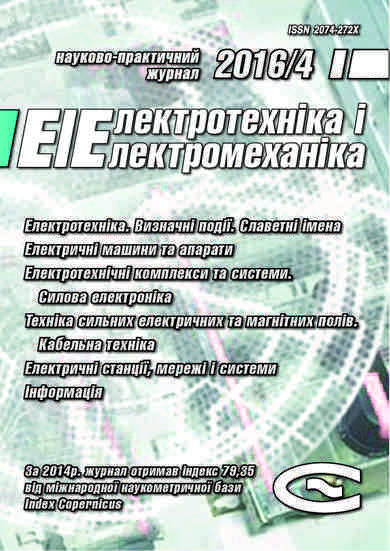INCREASING CONTROL’S EFFICIENCY FOR THE SHIP'S TWO-MASS ELECTRIC DRIVE
DOI:
https://doi.org/10.20998/2074-272X.2016.4.05Keywords:
ship's two-mass electric drive, control system, load sway, mathematical modeling, improvement, adaptability, stabilizationAbstract
Purpose. For shipboard lifting and transporting machinery (LTM) with AC thyristor electric drives (ED) the problem of minimizing sway through the formation of the special law to change the principle of ED control over the lifting process is solved. Methodology. This goal was achieved through the following objectives: analysis of current studies on the reduction of the negative effects of load fluctuations, fixed on the suspension with variable parameters; determining the criteria to optimize the movement of the lifting mechanism and transfer control laws under which the load fluctuations are reduced; develop the methodology and experimental study of the main characteristics of the mobile model ED lifting mechanism with its load suspended from the perspective of both the parameterization of the control system (CS) as well as elements of ED. For realization of tasks in research methods of mathematical modeling of dynamic processes on the computer, structural methods of control theory, experimental studies in the laboratory setting have been used. Results. Based on analysis of current research can be concluded that the stability of the ED of LTM to the disturbing points provided coincidence zero electric coordinates and speed deviation diametric plane of the vessel from the vertical position. Criteria for optimizing CS used by the ED LTM mathematical description of its dynamics differential equations to the estimated coefficients derived from the functions of state variables. The experimental dependence of dynamic equations of motion of an object under the influence of disturbing forces in the coordinate plane allowed to parameterize characteristic equation to the form, providing the solution to sustainability since the motor shaft of LTM. The functional circuit of CS eliminates the aperiodic components in the control in compliance with the criteria of sustainability and quality of transients by applying all-range regulator coordinate characteristics of forcing overcoming the dead zone and increase electric resistance as the dynamic object. Practical value. Completion of the complex research may find practical application in the ED of ship’s LTM, which will improve their performance, decrease between the operating and maintenance simple.References
1. C., Radisch C., Werner H. Active damping of container crane load swing by hoisting modulation – An LPV approach. 51st IEEE Conference on Decision and Control (CDC). IEEE, 2012. doi: 10.1109/cdc.2012.6426889.
2. Raubar E., Vrančić D. Anti-sway system for ship-to-shore cranes. Strojniški vestnik (Journal of Mechanical Engineering), 2012, vol.58, no.5, pp. 338-344. doi: 10.5545/sv-jme.2010.127.
3. Skaf J., Boyd S.P. Controller coefficient truncation using Lyapunov performance certificate. International Journal of Robust and Nonlinear Control, 2010, vol.21, no.1, pp. 55-78. doi: 10.1002/rnc.1577.
4. Belunce A., Pandolfo V., Roozbahani H., Handroos H. Novel control method for overhead crane’s load stability. Procedia Engineering, 2015, vol.106, pp. 108-125. doi: 10.1016/j.proeng.2015.06.014.
5. Balachandran B., Li Y.-Y., Fang C.-C. A mechanical filter concept for control of non-linear crane-load oscillation. Journal of Sound and Vibration, 1999, vol.228, iss.3, pp. 651-682. doi: 10.1006/jsvi.1999.2440.
6. Alli H., Singh T. Passive control of overhead cranes. Journal of Vibration and Control, 1999, vol.5, no.3, pp. 443-459. doi: 10.1177/107754639900500306.
7. Wua T.-S., Karkoub M., Yu W.-S., Chen C.-T., Her M.-G., Wu K.-W. Anti-sway tracking control of tower cranes with delayed uncertainty using a robust adaptive fuzzy control. Fuzzy Sets and Systems, 2016, vol.290, pp 118-137. doi: 10.1016/j.fss.2015.01.010.
8. Henry R.J., Masoud Z.N., Nayfeh A.H., Mook D.T. Cargo pendulation reduction on ship-mounted cranes via boom-luff angle actuation. Journal of Vibration and Control, 2001, vol.7, no.8, pp. 1253-1264. doi: 10.1177/107754630100700807.
9. Budashko V.V., Onishchenko O.A. Improving management system combined thruster propulsion systems. Bulletin of NTU «KhPІ», 2014, no.38(1081), pp. 45-51. (Ukr).
10. Budashko V.V., Onishchenko O.A. Mathematical principles of simulation of power plant’s control system at drillship. Bulletin оf Kamchatka State Technical University, 2014, no.29, pp. 6-13. (Rus).
11. Budashko V.V., Onischenko O.A., Yushkov E.A. Physical modeling of multi-propulsion complex. Collection of scientific works of the Military Academy (Odessa City), 2014, no.2 pp. 88-92. (Rus).
12. Budashko V.V., Yushkov Y.A. Mathematic modeling of all-range controllers speed of thrusters for ship power plants in combined propulsion complexes. Electronic Modeling, 2015, vol.37, no.2, pp. 101-114. (Rus).
13. Budashko V.V. Implementation approaches during simulation of energy processes for a dynamically positioned ship. Electrical Engineering & Electromechanics, 2015, no.6, pp.14-19. doi: 10.20998/2074-272X.2015.6.02. (Rus).
14. A.A. Bojko, V.V. Budashko, E.A. Yushkov, Bojko N.A. Synthesis and research of automatic balancing system of voltage converter fed induction motor currents. Eastern-European Journal of Enterprise Technologies, 2016, vol.1, no.2(79), pp. 22-34. doi: 10.15587/1729-4061.2016.60544.
15. Araya H., Kakuzen M., Kinugawa H., Arai T. Level luffing control system for crawler cranes. Automation in construction, 2004, vol.13, no.5, pp. 689-697. doi: 10.1016/j.autcon.2004.04.011.
Downloads
Published
How to Cite
Issue
Section
License
Copyright (c) 2016 V. V. Budashko

This work is licensed under a Creative Commons Attribution-NonCommercial 4.0 International License.
Authors who publish with this journal agree to the following terms:
1. Authors retain copyright and grant the journal right of first publication with the work simultaneously licensed under a Creative Commons Attribution License that allows others to share the work with an acknowledgement of the work's authorship and initial publication in this journal.
2. Authors are able to enter into separate, additional contractual arrangements for the non-exclusive distribution of the journal's published version of the work (e.g., post it to an institutional repository or publish it in a book), with an acknowledgement of its initial publication in this journal.
3. Authors are permitted and encouraged to post their work online (e.g., in institutional repositories or on their website) prior to and during the submission process, as it can lead to productive exchanges, as well as earlier and greater citation of published work.





